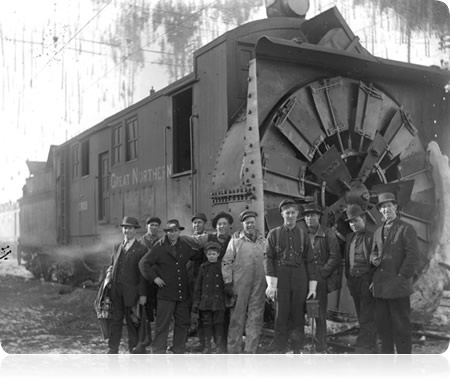I thought to myself the engine crews running a steam engine on a day like today had to be some tough men.
Thinking about it back then the workers did not have the winter weather clothing that we have today.
You would be surprised at the quantity, and quality, of excellent, "UNION MADE IN U.S.A." wool & cotton winter clothing available for the "Working Men & Woman", back in the day. At least one company still exists, and STILL offers top quality, "MADE IN U.S.A." winter clothing; The C. C. Filson Company, out in Seattle Washington. Since the "working class" people have diminished greatly in out country, all those companies like Penny's Big Mack line, Sears & Roebuck, Oshkosh, Dickies, and many, many others, have had to completely stop producing, convert to totally children's cloths made overseas, or make everything overseas.
You have to think Plastic was still one of those "new fangled products".
Inside the engine cab would have to be dripping with the condensation produced from the heat of the boiler and the snow coming down on the outside.
In these conditions the engine crews cloths would have to be soaked.
Obviously you have not been in a steam locomotive cab in VERY cold weather, as contrary to you statement about condensation, that simply doesn't happen. The temps in the rear portion of a cab, either an "all weather" enclosed cab or with the canvas curtain fully closed, may be pretty cold, but both of the forward seats, i.e. Engineer and Fireman, may be relative comfortable (NOT **** sleeve, but NOT below freezing either). The heat from the firebox/boiler is a pretty dry heat, and thus there really is no "dripping condensation". In fact, the back head of the boiler is an excellent place to dry one's wet/damp parka, hood, or gloves after having been outside.
Once they left the cab and got out in the elements there cloths would freeze and if they didn't freeze just the chill of having the wet clothing on would be bad enough.
Again, no. One's "wet clothes" don't freeze since one's closes rarely get wet.
Back then the engine crew were not going to take some Nyquil or Alka Seltzer Cold Medicine before they went to bed to stop the symptoms of a cold.
You are correct here. However, remember that back in the "good old days", the majority of railroad men where drinkers. That's how they recovered and got to sleep.
Getting your cloths dry overnight for the next shift would be a task in itself.
Drying of clothes was pretty simple; place them on a radiator in your room, or hang them near the cast iron coal stove.
On a day like yesterday running a steam engine may not be the most glamours job on the railroad.
You are definitely correct there!
I think these engine crews would have to have been one tough breed!!!!!
They were. They worked hard and also "played hard".
Now, from my own experiences, I have never found the cold, or even bitter cold, to be THAT much of an issue. However, high heat along with high humidity is the real problem. While on duty in the cab of UP 3985, running across the California & Utah desert, the outside temps ranged from 108 degrees to 110 degrees as read off by the hotbox detectors, yet the thermometer inside the cab showed 145 to 152 degrees! Believe it or not, it was not REALLY that uncomfortable! You did constantly have to drink water & Power-aid in order to keep hydrated.
Conversely, when operating in the southwestern states, where the humidities readings are over 75% and the temps are near 90 degrees, those working conditions are simple brutal and totally sap your energy.
However, the hottest environment I have ever been working in, was the second locomotive of a doubleheader inside a long 2 mile snowshed/tunnel, on the former Souther Pacific westbound grade on Donner Pass, enroute to the 1999 RailFair in Sacramento, CA. The GE diesel helper failed upon entering the show shed, so we had to go to full throttle on Challenger 3985. We never actually found out the internal cab temperature because the thermometer melted and fell onto the steel cab floor. The extreme heat seriously "sun burned" my arms to a bright red, in minutes! We estimate the temp was 200 degrees or better, and probably would have killed us if not for the protective breathing hoods we put on prior to entering the snow shed. We then understood exactly why the SP developed those huge cab forwards!




